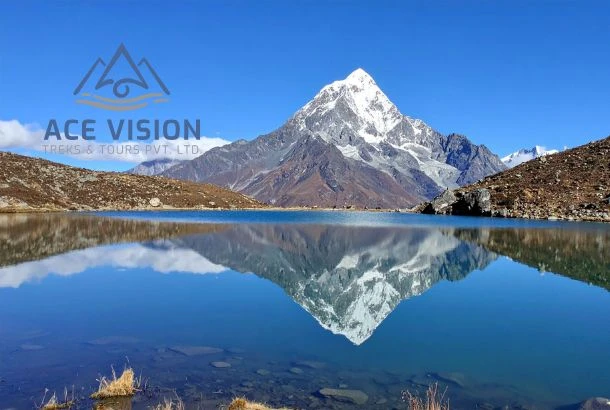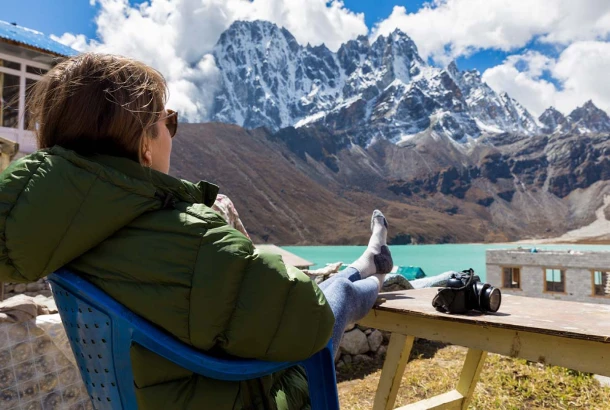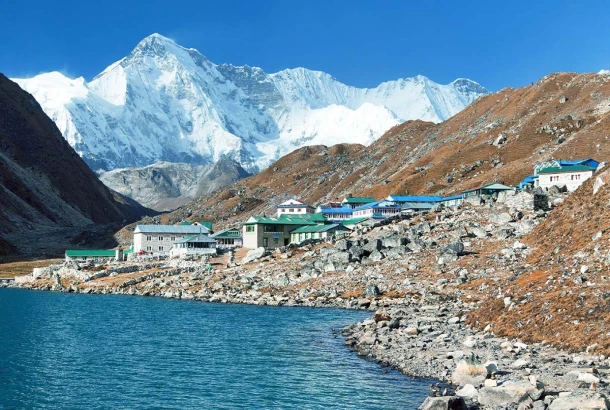What is Nepal most famous for?
Iconic Mountains & Trekking Regions
Nepal is synonymous with its Himalayan peaks, which attract hikers and climbers from all over the world. It is a country where adventure and culture coexist. Here, every ascent reveals the glance of snow-covered peaks, and rich culture, especially Tibetan. Trekking here is not just a physical journey; It is an emotional and cultural recess that connects you to both nature and local communities that reside in Himalayas.

Mount Everest and The Legendary Himalayas
Mount Everest (8,848.86 m) is called "Sagarmatha" in Nepali and "Chomolungma" in Tibetan. Exceeding just a mountain, it's a global icon and definitely one of the major attractions of Nepal. The name itself develops thrills and amazement. The area around Everest is part of Sagarmatha National Park, a UNESCO World Heritage Site that is known for its magnificent alpine scenes, glaciers and rare wildlife such as Snow Leopard, Himalaya Tahar and Red Pandas.
Everest Base Camp Trek (EBC) is one of the most famous treks in the world. Usually it's a 12-14 day trek. One of the important highlights of the trip is an exciting and thrilling flight to Lukla. The trail passes through the picturesque villages such as Namche Bazaar, Tengboche, Dingboche, Lobuche and Gorakshep.
The trail passes through dense pine and rhododendron forests and after crossing the suspension bridges, it takes you to the Tengboche monastery(3,860 meters / 12,664 feet). This place is a prestigious spiritual stop with a mesmerizing background scene of Everest. Upon ascending higher, the landscapes become steep and glacial, leading to Lobche (4,940 meters / 16,207 feet), and finally to Gorak Shep(5,164 m), the last settlement before the base camp. Standing in Everest Base Camp (5,364 meters), surrounded by the Khumbu Icefall and the majestic Everest itself, is a dream for every nature lover.

Annapurna Circuit & Base Camp Treks
If Everest is mythological, the Annapurna region is popular for its great diversity. Here you can cross the subtropical forest of rhododendrons to alpine, and an almost lifeless desert in the same trip.
Annapurna Circuit Trek is often seen as one of the best long treks in the world. Requiring about 14-18 days, the trek takes you through various scenic landscapes and communities of Gurung, Thakli and Magar peoples. On the way, you will also visit attractive villages like Manang (3,519 m). In these villages, traditional stone houses, prayer flags and amazing panoramas of the Annapurna and Gangapurna massifs stand as the highlights.
The trek crosses the Thorong La Pass (5,416 m), one of the highest navigable mountain passes on earth. Your hard work is rewarded with panoramic scenes of the Annapurna and Dhaulagiri ranges. Without retracing the path for return, the trail then takes you to a sacred pilgrimage, Muktinath. Here, Hindus and Buddhist devotees bathe in the 108 Holy water spouts, renowned to erase one’s sins. The route continues through Kali Gandaki Valley. This valley is known for its dramatic landscapes and fossils, built into river beds.
Likewise, Annapurna Base Camp (ABC) trek offers a 7-10-day journey in the heart of Annapurna Sanctuary. This natural amphitheater is surrounded by peaks such as Annapurna (8,091m), Machapuchare (6,993 m) and Hiunchuli (6,441 m). The tour mixes alpine beauty with cultural recess and the friendly hospitality of Gurung villages such as Ghandruk and Chomrong. Many also choose to trek to Jhinu Danda for the Hot Springs. The place is a perfect relaxation spot after the trip.

Upper Mustang trek: A trek through the forbidden town
For a traveler who loves mystery and culture, the Upper Mustang is ideal. Located under the rain shadow of the Annapurna and Dhaulagiri series, the region is also accessible during Nepal's monsoon. Once part of the ancient Lo Kingdom, this place was forbidden till 1992 for outsiders. This is the reason why it is called the Forbidden Kingdom. Visiting this place feels like traveling back in time as everything, even the rock, tells you ancient stories.
The journey begins in Jomsoom, where trails are curved through rocky cliffs. The main place to focus is Lo Manthag (3,840 m), which is a town frozen in time. Here, white brick houses, old monasteries, and the Royal Palace still showcase the bygone era.
The upper Mustang is also known for the Tiji festival, which is a three-day procession of masked dances and rituals, symbolizing the victory of good over evil. Discovering its mysterious sky caves and stone carvings is an experience not to miss in Mustang.
Unlike regular Himalaya treks, the desert-like region of Mustang, with multi-hued cliffs, provides a fascinating beauty. This trek is as much about cultural discovery as it is about landscapes. Tibetan Buddhism is still practiced in its pure form, telling the world how ancient the place is.
Manaslu and Tsum Valley - Off-the-Beaten Trek Beauty
If you are looking for raw forests and smaller crowds, the Manaslu Circuit Trek is Nepal’s best-kept secret. Mount Manaslu (8,163 meters) is the eighth-highest peak in the world. The trek stretches for 14–16 days and reflects the diversity of the Annapurna Circuit.
The trek begins in the lower foothills, where terraced fields and subtropical forests are the scenes you'll likely enjoy. Ascending further, trekkers pass alpine pastures, high passes, and snow-covered trails(especially in winter). Villages such as Samagaon and Lho sit under huge glaciers and feature carved prayer walls (mani walls) and lively monasteries.
From here, trekkers often move towards the Tsum Valley, a Himalayan valley long considered to be sacred. Tsum means the “Valley of Happiness”. This beautiful valley with an equally beautiful name is home to centuries-old gompas like Mu Gompa and Rachen Gompa. These are still maintained by monks. Prayer flags flutter over suspension bridges, and trails are lined with chortens (Stupas) reflecting deep spiritual roots.
Crossing the Larke La Pass (5,106 m) is the highlight of the trip, rewarding trekkers with wide views of Manaslu, Hiunchuli, and Cheo Himal. This route is perfect for those seeking a true wilderness adventure combined with rich Buddhist culture.
Why These Treks Matter? |
|---|
Because every step you take here brings you closer to something magical and unforgettable. Just imagine standing face to face against Everest’s towering summit that silences big egos just by its grand presence. When you wander through the hidden kingdom of Mustang, you will feel like travelling back in time. Therefore, trekking in Nepal is more than just walking through stunning landscapes. It’s a journey that changes how you see the world and yourself, and that's the reason these matters. |
Nepal's Which cities Blessed culture and Nature?
Nepal’s cultural heritage is reflected in its timeless architecture, complex temples and diverse ethnic groups. And the natural beauty is reflected in every step, in each unique city. Here are some cities that are themselves the Major Attractions of Nepal.
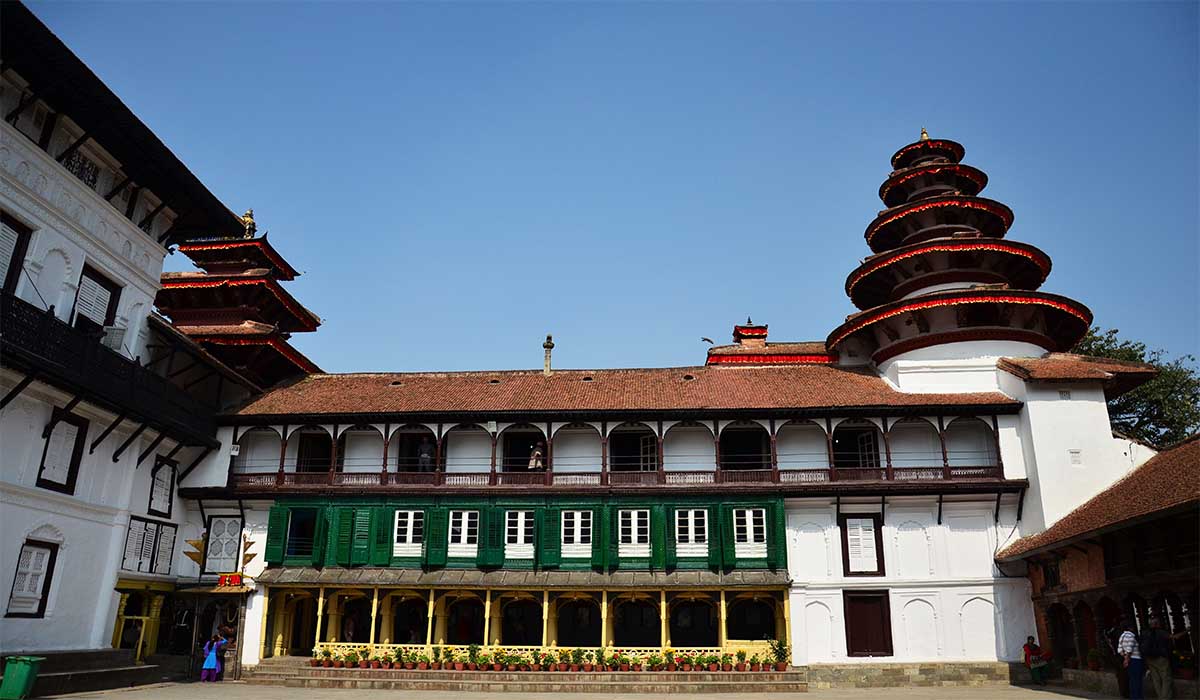
Kathmandu Valley - Temple, Heritage and Chaos
The Kathmandu valley is the cultural and historical hub of Nepal. Most people don't know, this city is home to three old cities in itself: Kathmandu, Patan (Lalitpur) and Bhaktapur. Each is a treasure of art, inherited architecture and historic museums where centuries-old palaces, pagodas and temples stand with lively markets and modern life. Visit them for an enriching cultural immersion and go for day hikes to connect with nature.
Kathmandu has a famous Durbar Square, which is a World Heritage Site of UNESCO. It is full of carved wooden windows, courtyards and royal palaces. Just a few kilometers away, there is the sacred Pashupatinath Temple at the Bagmati River bank which is considered one of the most important Hindu temples in Nepal. The daily rituals and cremation ceremonies under the open sky make it a major source of Nepal's tourist attractions.
Patan, also known as Lalitpur, is known for its lovely Newari Craftsmanship. Patan Durbar Square is full of fine metal work, stone sculptures and iconic Hiranya Varna Mahavihar (Golden Temple).
Bhaktapur, often called "City of Devotees, is a medieval town in the valley. The Bhaktapur Durbar Square has a famous 55-Window Palace, the Nyatapola Temple (the highest pagoda in Nepal) and Taumadi Square. Walking through the narrow streets of Bhaktapur gives a glimpse of traditional Nepalese life, from mindblowing handicrafts to mouthwatering local dishes such as Juju Dhu (yogurt).
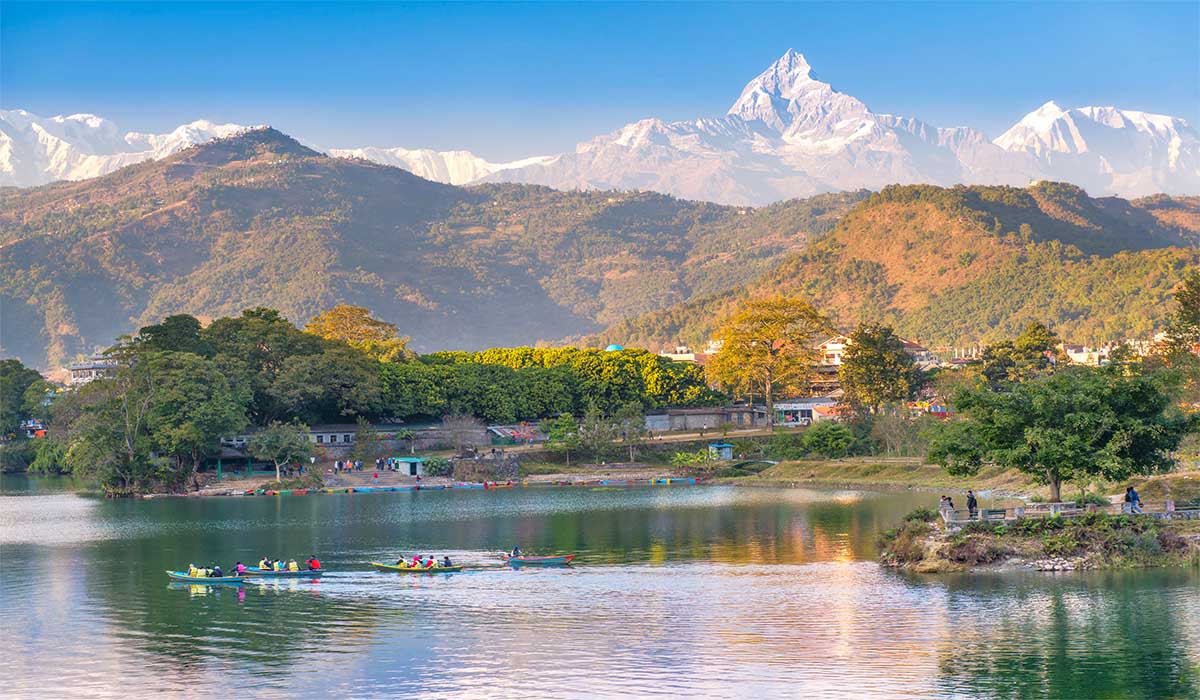
Pokhara - Gateway to Annapurna
How could Pokhara be missed when we talk about a city rich in nature and culture? Bringing large volume of tourists and being rich in natural wonders, Pokhara is also called the tourist capital. Its specialties are beautiful lakes, amazing caves, lovely waterfalls, and calm mountain views. When you are in Pokhara, you have full of options to enjoy. You can boat on Fewa Lake, Begnas Lake or Rupa Lake. These are famous for their tranquil environment and the mesmerizing scenes they provide by reflecting the Annapurna and Dhaulagiri ranges. There are caves to explore. Gupteshwar Mahadev Cave is surprising and religiously important and Mahendra Cave is thrilling. The Davis Falls is another must-visit places in Nepal. Watch the waterfall vanish in a deep underground tunnel in this natural wonder. Explore the city, there is a lot more places to explore.
Pokhara is known as the starting spot for many treks. Several treks in the Annapurna region start from this region. This includes the popular Annapurna Base Camp trek (ABC trek) and the Annapurna Circuit trek. So, not only for city tourers but also for Himalayan trekkers, Pokhara is a must-visit destination in Nepal.
It also has a rich cultural heritage in itself. The tranquil Fewa Lake, residing next to it, mixes the city’s natural beauty with a relaxed lifestyle. Likewise, several cultural sites such as the World Peace Pagoda (Shanti Stupa) provide a surprising view of the Annapurna series, and temples like Baharai and Bindabasini attract tons of visitors, particularly during festivals.
The ethnic communities of Pokhara, including Gurung and other groups, contribute to the city's cultural vividness through their music, dance, and traditional crafts. Visitors can discover local markets, taste authentic Nepalese recipes, or participate in traditional music and cultural performances, making it not only an entry point for adventure but also a place to soak in the Nepali spirit.
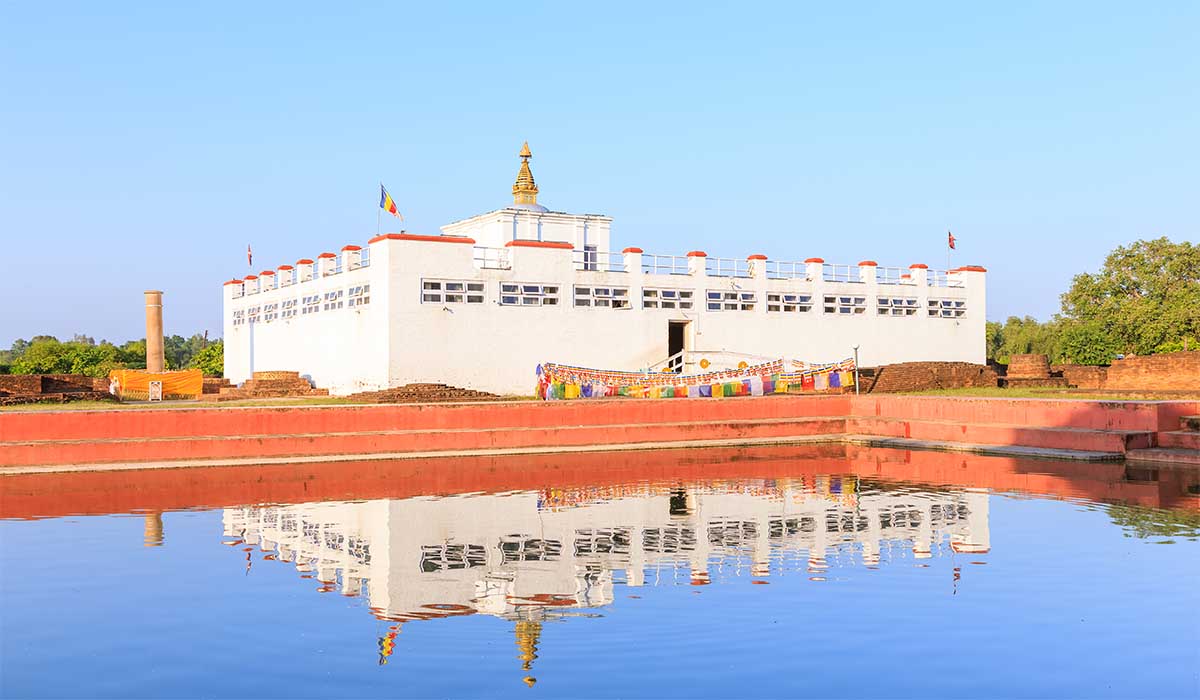
Lumbini - Birthplace of Buddha
Lumbini of the Rupandehi District is the biggest religious site of every Buddhist Pilgrimage and one of the Major Attractions of Nepal. It is equally praised by Hindus and other religions. As you might know, the Light of Asia, Gautam Buddha, was born here. That’s why the place is significant not only culturally but also spiritually. It is already recognized as one of the UNESCO World Heritage sites. Every year, thousands of tourists and Nepali Visitors come to this place to experience the tranquility and deep-rooted history.
When you are in Lumbini? you must not forget visiting the Mayadevi temple. This is in the sacred garden. This temple was built to mark the exact birthplace of Buddha. To make it more exact, a pillar was made by an Indian Emperor, King Ashoka, with a note describing the place as the exact birthplace of Prince Siddhartha Gautam. The pillar is now called the Ashoka Pillar.
There is also a monastic zone in Lumbini, which is one of the major attractions of Lumbini. Inside this zone, several countries have built monasteries that depict the art, architecture and culture of their own country. These countries include Thailand, Myanmar, Cambodia, Sri Lanka, China, Japan, Germany, France, Austria, South Korea, Vietnam, Canada, and India.
Besides, there is a World Peace Pagoda on the hilltop. This is like a destination for many people. From the hilltop, this stupa provides a wide and panoramic view of the entire town. But most importantly, it provides a serene and peaceful atmosphere, which is why many love this place. This provides a great getaway from the city and a perfect spot for meditation and relaxation.
Why explore these cities of Nepal? |
|---|
A country whose specialty is the blend of history, religion, artistry, and community life can enrich the experience of any traveler. These cities of Nepal connect you to the heart of the nation's identity. Come and explore. These natural and cultural treasures are waiting for you. |
Why Nepal rich in Nature and Wildlife diversity?
Nepal's wonderful natural beauty is not just the huge Himalayas. Even the lowland of Terai region holds some of the most diverse ecosystems in Asia. They provide shelter to rare and endangered wildlife. The lush green forests, grasslands, and river landscapes are also beautiful to enjoy and take photographs. If you are a nature lover or a wildlife enthusiast, do not miss out to explore the National Parks and Conservation areas. Here, rare animals roam freely and birds fill the sky.
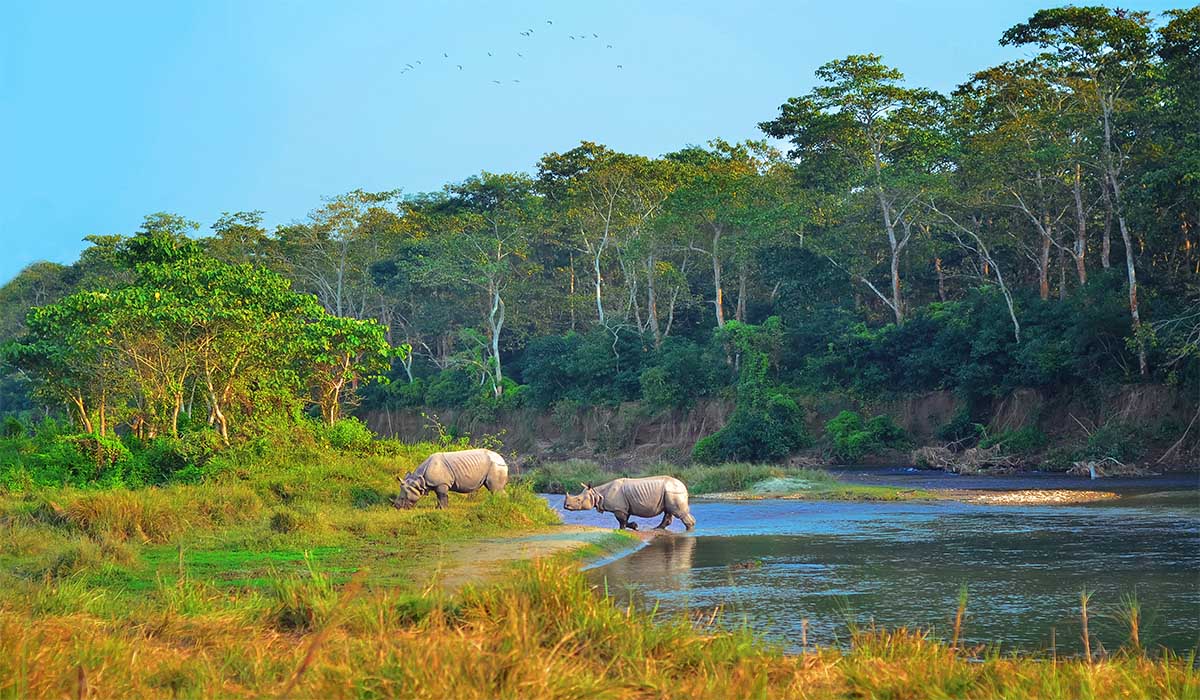
Chitwan National Park – a safari experience
Chitwan National Park was established as Nepal's first national park and a UNESCO World Heritage Site in 1973. It is certainly the best destination in Nepal to experience a wildlife safari. It holds a remarkable variety of species, including the endangered one-horned rhino, elusive Bengal tigers, and large herds of elephants and gives you a once-in-a-lifetime opportunity to be just a few meters away from them.
Visitors can enjoy guided jeep safaris, canoe rides on the Rapti River, and tours led by trained naturalists who will reveal the secrets of the forest on the journey. It is easier to spot wildlife in the drier season as animals gather near watering ponds. If you love birds, you are getting a lot in the tour. Because over 500 recorded species of birds are found here. These also include famous birds like kingfishers and rare ones like hornbills.
The buffer zone around the park is home to the Tharu community, known for its traditional culture, unique dances, and harmonious relationship with nature, adding a cultural dimension to the safari experience.
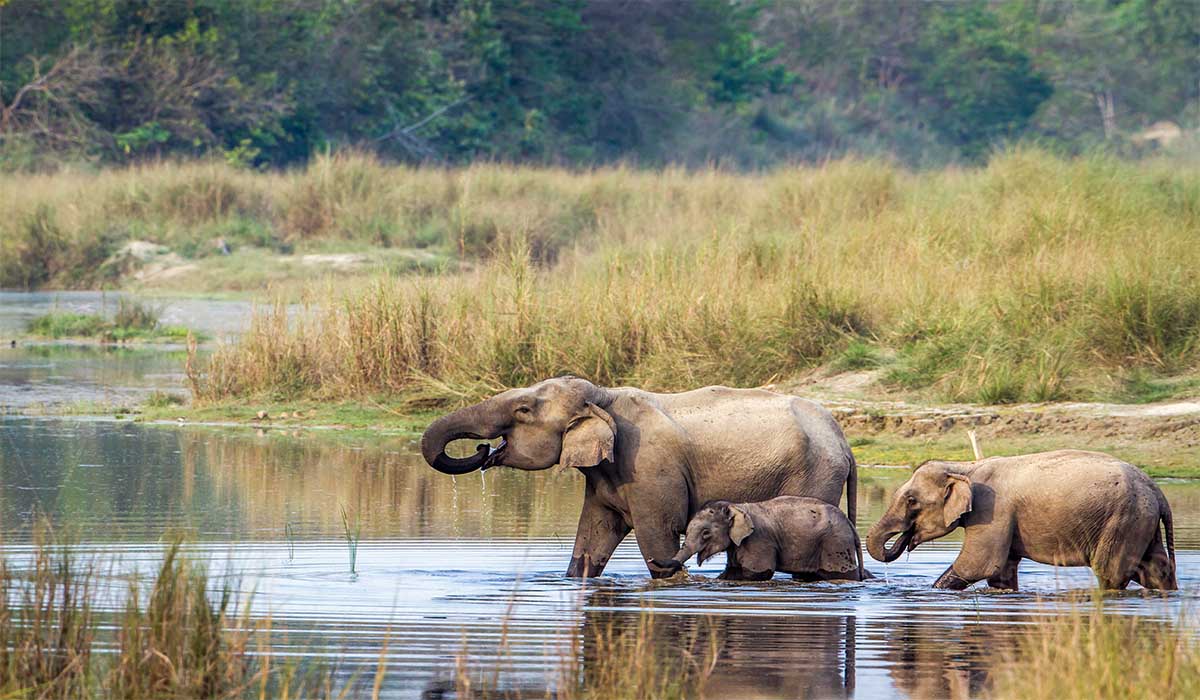
Bardia National Park – Western Wilderness of Nepal
Yes, Chitwan is more popular and accessible. However, Bardia National Park is an equally pristine National Park in western Nepal. It even offers more wilder and more intimate wildlife experience. Covering more than 968 square kilometers, it is the largest protected area in the Terai. The place is home to species like rhinos, tigers, elephants, swamp deer, and wild boar.
The remote location of Bardia is the reason for fewer tourist attractions. But this can be advantageous if seen from another perspective. Due to fewer number of visitors, it allows peaceful jeep safaris and rafting through dense forests, grasslands, and river areas.
The Bardia National Park is the best tiger habitats in Nepal, and even one of the best in Asia. Due to the same reason, the sightings are more frequent than in Chitwan. The landscapes vary from sal forests to grasslands. This provides a rich habitat for birds, reptiles, and mammals. So, if you are a nature lover who is seeking a real jungle adventure, Bardia is your hidden gem.
Why explore Nepal's wildlife? |
|---|
Discovering Nepal's nature and wildlife offers an exciting contrast to the mountains, bringing you face to face with some of the most iconic and endangered species on the planet. Just imagine how much you will enjoy discovering Rhinos and tigers in the dense jungle and canoeing in the full wilderness. |
Religious and Pilgrimage Sites
Nepal is truly a spiritual hub. Here, ancient Hindu and Buddhist traditions harmoniously coexist in the shade of the wonderful Himalayas. The Religious and Pilgrimage Sites are also one of the major reasons for the growing Tourism in Nepal. These sites invite millions of devotees and pilgrims who come here seeking blessings and inner peace.
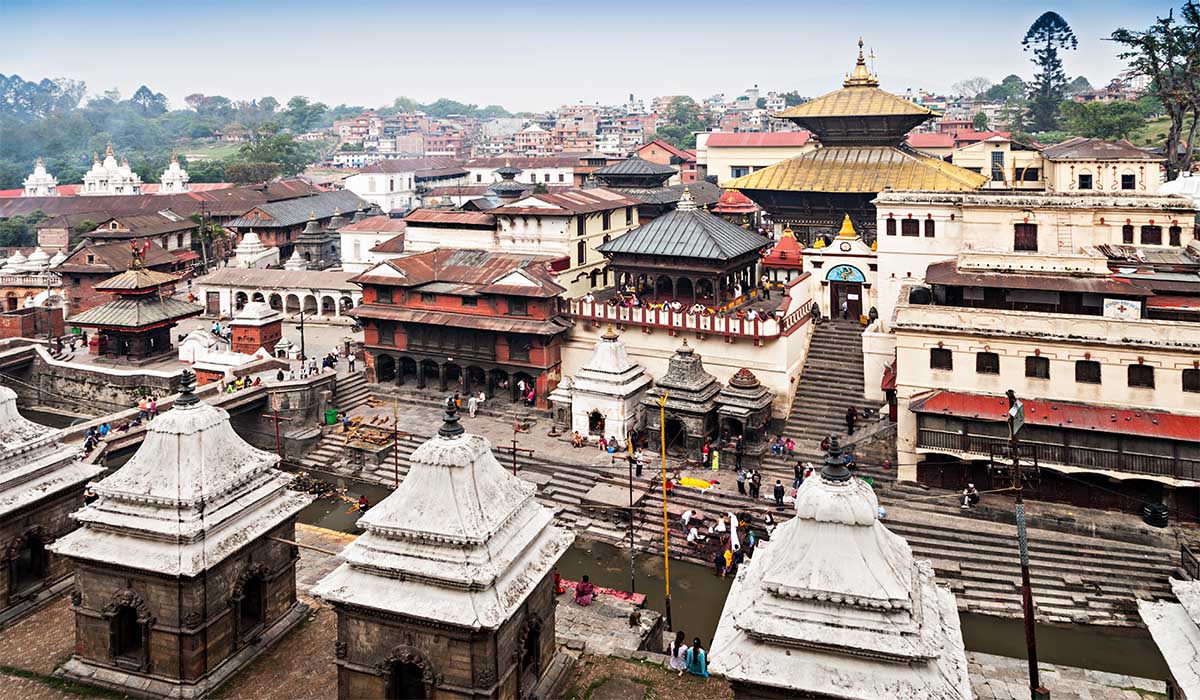
Pashupatinath Temple – a Hindu sacred Shrine
Located on the banks of the holy Bagmati River in Kathmandu, the Pashupatinath Temple is the most prestigious pilgrimage site of Lord Shiva in Nepal. Lord Shiva is the destroyer and transformer in Hindu belief. This grand temple complex is an outstanding example of pagoda architecture, featuring roof of gold. The temple possesses a deeply spiritual atmosphere.
The temple is busy every day of the year with daily with rituals, mantras, and ceremonies. The evening Aarti (prayer ceremony) is a profound experience. You will enjoy the tandava chanting and sacred rites performed by the priests. The ghats along the river serve for cremation. This is a place where you totally feel influenced by a divine power. Many reports that people realize the cycle of life, death, and rebirth and understand life. Moreover, there are Sadhus. They don't wear dresses, just cover their bodies with ash, which they call bhasma. Simply, they depict the aura of asceticism and ancient tradition.
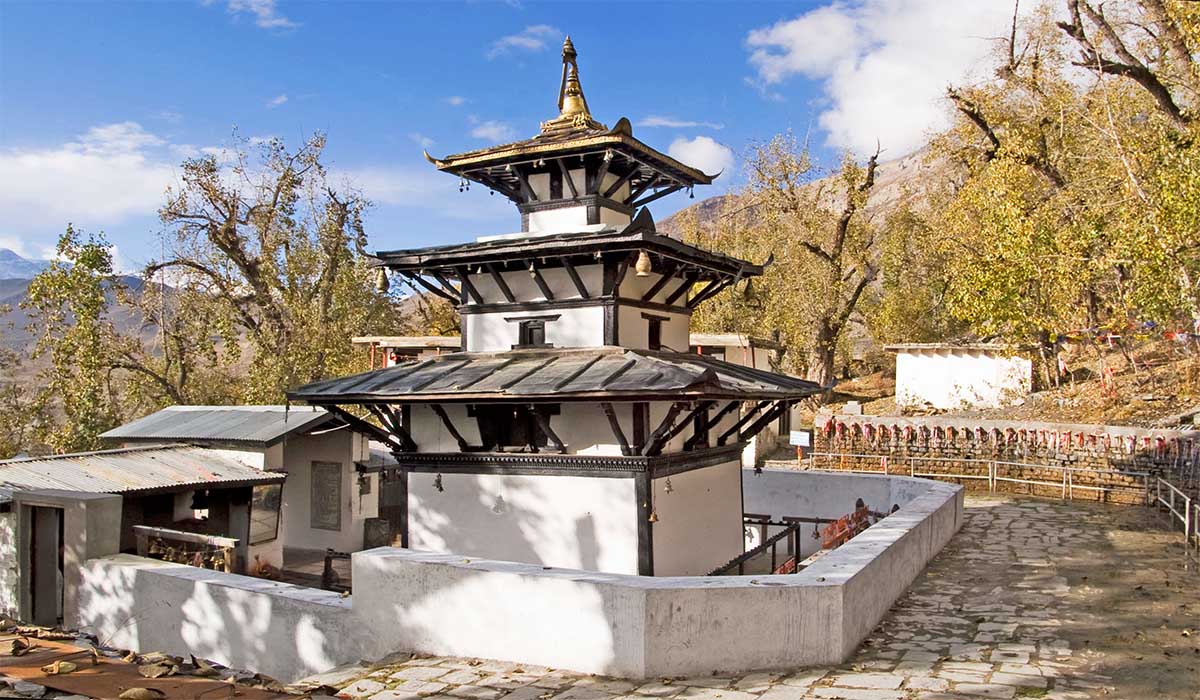
Muktinath Temple – Where Faith Converges
Muktinath Temple, located at an altitude of 3,710 meters in the Mustang region, is a unique pilgrimage site revered by both Hindus and Buddhists. Its name means "the place of liberation," and devotees believe that visiting here washes away sins and frees the soul from the cycle of rebirth. The temple’s main feature is its 108 sacred water spouts, from which icy mountain water flows continuously. Pilgrims bathe beneath them as an act of purification.
The journey to Muktinath is surrounded by beautiful landscapes of the Himalayas, making it a spiritual pilgrimage mixed with physical adventure. The temple complex also includes a Buddhist Gompa, symbolizing the region’s religious harmony. This temple is also a significant stop on popular trekking routes such as the Annapurna Circuit and Upper Mustang.
Gosaikunda Lake – The Holy Lake of High Altitude
The Gosaikunda Lake is located at an altitude of 4,380 meters in the high heights of Langtang National Park. The Lake's spirituality is enhanced by the myth and devotion of pilgrims. According to Hindu tales, Lord Shiva created this glacial lake by striking the mountain with his trident. This left sacred water behind that is believed to have healing properties. Even for the Buddhists, the lake holds the same purity and spiritual significance.
Every year when the Janai Purnima festival comes, thousands of pilgrims visit Gosaikunda to bathe in its icy waters. This is because they believe that the Lake's water cleanses their sins and brings good fortune.
Besides the spirituality, the journey to Gosaikunda is also an incredible trek through alpine forests, rhododendron blooms, and snowy mountain vistas. This combines the natural beauty and physical efforts with deep spiritual discovery.
Pathivara Devi Temple – The Divine Sanctuary
The Pathivara Devi Temple is located in the remote eastern hills of Nepal in the Taplejung district. It is a very sacred Hindu shrine with various myths associated. The temple is dedicated to Goddess Pathivara Devi, who is believed to be an incarnation of Durga. Sitting at an altitude of 3,794 meters and lacking a decent route, the temple is only for true devotees and believers. Even though it attracts pilgrims from Nepal, India, Bhutan, and Tibet, reaching the temple requires several days of ascending.
Pathivara is considered a very powerful site for seeking wish fulfillment, sin cleaning, and spiritual blessings. Its dramatic setting between the snow-covered Kanchenjunga range enhances its beauty.
Other Spiritual Pearls
Swayambhunath Stupa (Monkey Temple) is one of Nepal's oldest and most sacred Buddhist sites. It stands at a hilltop in the Kathmandu Valley and provides a wide view of Kathmandu. The giant Buddha eyes painted on its dome, colorful prayer wheels, and playful monkeys are its major highlights. But above all, the temple is popular for the peaceful environment that this temple provides, even in between the overwhelming number of crowds.
Boudhanath Stupa is another whitewashed stupa and one among many of the Major Attractions of Nepal. It serves as the spiritual heart of Tibetan Buddhism in Nepal. The mantras chanting and spinning prayer wheels are its notable attractions.
Janakpur is believed to be the birthplace of Goddess Sita. If you have learnt the Ramayan, you must know that she was the wife of Lord Ram. In Janakpur, the magnificent Janaki Temple stands as an architectural marvel and center of devotion. This is Nepal's biggest temple. Here, the Vivah Panchami festival is celebrated with joy and delight by every resident. This attracts thousands of pilgrims to celebrate the divine marriage of Ram and Sita.
Why are these religious places one of the Major Attractions of Nepal? |
|---|
These sacred sites introduce you to Nepal's spirituality and cultural identity. They are places of devotion, history, art, and living tradition. Still today, they are inviting travelers to experience rituals, festivals, and moments of deep peace. Whether you are a pilgrim, a spiritual seeker, or a curious traveler, Nepal's religious sites can provide you with a profound and enriching experience. |
Cultural Festivals and Traditions
The festivals in Nepal are a reflection of Nepal's diverse cultural and spiritual identity. These are in large numbers and are celebrated with enthusiasm across the country. The biggest one for Hindus is Dashain. This festival lasts for 15 days in the autumn season, when Tourism in Nepal is at its peak. The festival symbolizes the victory of good over evil. At this time, families reunite, elders bless younger ones with tika, and the environment becomes alive with decorated homes, fairs, and bamboo swings in villages.
The five-day festival of Tihar is celebrated in October or November. This festival honors animals such as crows, dogs, cows, and oxen. During the third day, Lakshmi Puja, houses and streets glow with oil lamps and colorful rangolis. In addition, the traditional songs and dances known as Deusi-Bhailo make this festival the most delightful ones.
Holi is quite popular festival celebrated in March. It fills the streets with vibrant energy as people throw colors and water balloons. The festival marks the arrival of spring and promotes unity and joy. Also, the unique Indra Jatra in Kathmandu is an eight-day festival held in September. It honours the rain god Indra with masked dances and formal rituals. If you visit Kathmandu at this time, you must not miss the chariot procession of the living goddess Kumari. This turns the whole city into a cultural celebration.
Similarly, there are various other festivals with their own importance. Maghe Sankranti marks the winter solstice with traditional feasts. Teej is a women’s festival where they fast, dance and worship Lord Shiva. Buddha Jayanti celebrates the birthday and enlightenment day of Lord Buddha. And likewise, the Chhath Parva is dedicated to Suryadev (Sun Deity) with riverbank rituals.
Experiencing these festivals means understanding Nepal’s living traditions deeply. The large number of festivals in Nepal ensures you are likely to experience one of them in whichever season you visit.
Adventure Activities Beyond Trekking
Nepal is a paradise for adventurers. Well, you might have heard the same for trekking, none are incorrect. If you are a thrill-seeker, this fact is for you - this country is a playground of exciting and thrilling activities set against stunning natural backdrops. You'll find adventure wherever you seek. Literally, from the skies to rushing rivers and deep valleys, every place can be changed into an adrenaline-filled fun.
Paragliding – Soar Over the Himalayas
Few experiences match the thrill of paragliding in Pokhara, where you glide over Fewa Lake with sweeping views of the Annapurna and Machapuchare ranges. As you soar like a bird, the lakes below you and snow-capped peaks on the horizon create a truly amazing panorama. Tandem paragliding is the most popular option. In this paragliding, trained pilots handle the technical side and you can simply enjoy flying.
For those wanting even more, there is the Sarangkot takeoff point. It is famous for its sunrise views. So, morning paragliding here is both scenic and peaceful. Pokhara is now one of the world’s best paragliding sites, attracting enthusiasts year-round, especially in autumn and spring.
White-Water Rafting and Kayaking – Snow-Fed Rivers
Nepal’s snow-fed rivers offer some of the best rafting and kayaking in Asia. From mild rapids suited for beginners to intense Grade IV and V rapids for experts, there is something for everyone.
Popular rafting rivers include the Trishuli River (ideal for short trips near Kathmandu), the Seti River (great for families and beginners), and the Bhote Koshi River ( known for its powerful rapids). For longer and a more remote adventures, the Sun Koshi River offers multi-day rafting through old valleys and villages, combining adventure with cultural discovery.
Bungee Jumping and Swing – Dive into the Great Gorge
For pure adrenaline, bungee jumping in Nepal is unforgettable. The Last Resort near the Tibetan border offers one of the highest bungee jumps in the world. It is a 160-meter jump into the gorge of the Bhote Koshi River. Below are the lush hills and rushing river, which make the jump stunning and heart-pounding.
If you could not muster up the courage to do the bungee jump, there's its light version as well. It's called the canyon swing. It is not exactly the bungee jump, though it gives a similar thrill. The experience of free-fall before swinging over the gorge is mainly what gives such a thrill. Both of these activities are safe and supervised by professionals. So, even if you are a first-timer, you can do it safely.
Mountain Biking – Explore Offbeat Trails
Nepal’s rugged terrain and scenic landscapes are perfect for mountain bikers. Biking in Nepal combines rural trails with culturally rich destinations. For short and single-day experiences, there are many options near Kathmandu. However, if you are looking for a multi-day experience, the trails in Jomsom and Upper Mustang provide epic routes through dramatic landscapes and remote settlements.
Jungle Safari – Adventure for Wildlife Lovers
Beyond the mountains and rivers, the jungle safaris are also very popular options for an adventure soul. As already explained in the 'Nature and Wildlife' section, Chitwan and Bardia are two of the National Parks that can offer you true wilderness in the forest. There are a lot of options, including Jeep safaris, canoe rides, and guided forest walks.
Why Try Adventures Beyond Trekking?
These activities highlight Nepal’s versatility as a destination. You can soar over the Himalayas, raft through the rapids, leap into deep gorges, or ride through hidden villages. By trying anyone of these, you can experience one of the times of your life.
Conclusion
Summarizing the blog, Nepal is a country filled with wonders. The breathtaking views of the Himalayas, Kathmandu's culture, the adventure in Pokhara, the wildlife of Chitwan and Bardia, and the tranquility of Lumbini are some of the major attractions of Nepal. Besides, there are religious places and festivals that attract a large number of tourists.
Visiting Nepal is a hundred percent fruitful experience till you do it safely. Choose an experienced and reliable trekking agency as your partner and find your perfect time to visit Nepal, before you tie your laces up.












